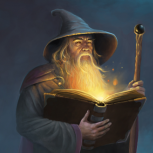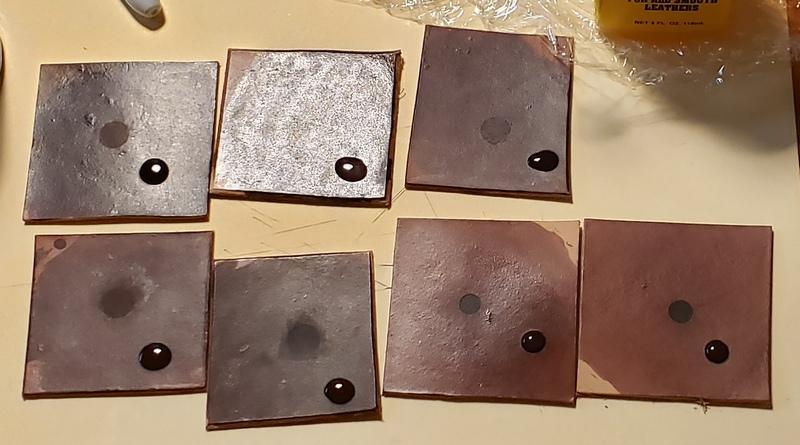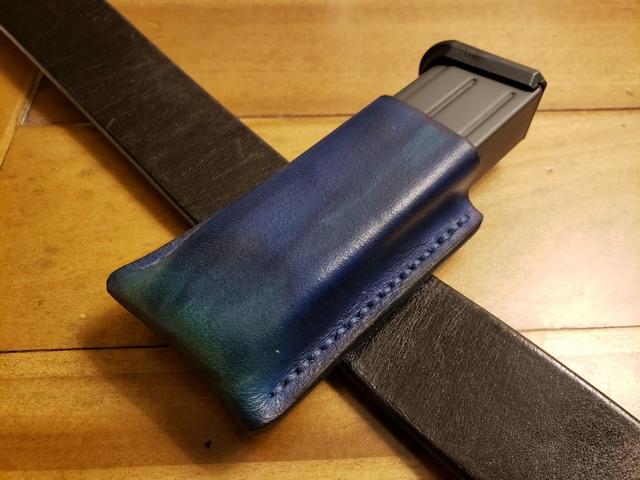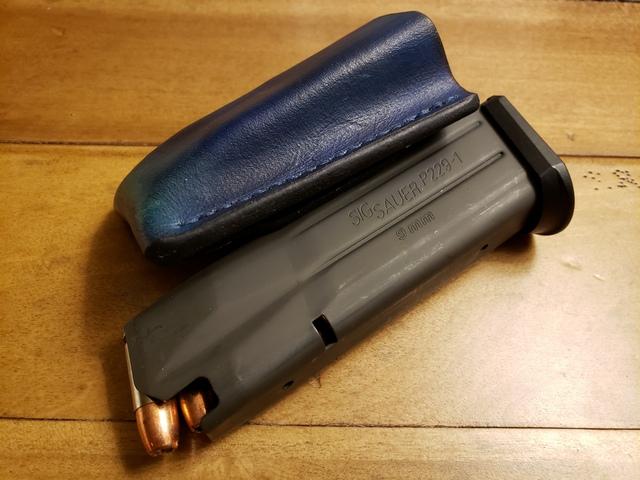-
Posts
555 -
Joined
-
Last visited
Content Type
Profiles
Forums
Events
Blogs
Gallery
Everything posted by wizard of tragacanth
-

Ideas for upholstery leather?
wizard of tragacanth replied to zuludog's topic in Leatherwork Conversation
You could use it for lining jewelry boxes, valet trays or some such thing. Wrap tool handles? nick -
My local Tandy has a new display of several different machines. They have a hot foil stamper, a clicker press and a couple of others. They are definitely upgrading their own products, such as their Craftool Pro tools and incorporating desirable products from well know manufacturers. Several months ago, they gave me a survey for my likes and dislikes, regarding their inventory, things that I would like to see added to their inventory, etc. They are doing everything that they can to stay competitive. I applaud their efforts. I think we are seeing the beginning of a new and better Tandy. nick
-
I was also very surprised by the results with Sno Seal and Shoe Polish, but as I said, I did only one application and did not warm the leather. In the next day or two, I am will do a second coat on all of them and re-test. The results could change significantly. Maybe this time, I will remember to put a Control Sample in the test, especially for color comparison. nick
-

Edge Bevelers: Barry King vs. Ron's
wizard of tragacanth replied to jdwhitak's topic in Leather Tools
Thanks zuludog. I think that I will go over to Tandy and see if they have a Pro Classic that I can try in the store. nick -
Yesterday, I tested seven different finishes. These were applied over Fiebing’s Pro Mahogany. I was looking for: color change, level of gloss, flesh burnishing and waterproofing qualities. This report is not super organized and may contain errors but I think it conveys the basic results of my tests. I do not wish to spend more time to perfect it because it was a casual test anyway. I put two drops of water on each sample. After one minute, I wiped off one drop of water and let the other sit until it was completely absorbed (over an hour or two). I wanted to know the short term and long term water resistance of these products. When the samples were completely dry, I buffed them in attempt to “repair” them as much as possible, without re-treating them. Buffing did slightly improve their appearance. The damage actually came in the form of cratering. It appeared that the solution had evaporated completely off of the sample. The edge was easy to see and feel. The crater was approximately 1/20 of a millimeter deep. Resolene won the water test. It was completely waterproof. I had a thick coat on there. The color change was quite dramatic but Tan Kote was even more so. Tan Kote was second best. The one minute test showed damage only if the light was reflected off of it in just the right angle. The long term test was a little bit easier to detect but not too bad. Tan Kote resulted in the deepest color change. Shocking, actually. Very dark brown. Satin Shene was a surprising third. The short test did show a very slight discoloration and some loss in gloss. You could tell there was some damage but it was minimal. Color change was very significant. Gum Tragacanth and Tokonole were tied. More damage on both areas than Satin Shene. Sno Seal and Shoe Polish were by far the worst. I must qualify this by saying that I did not warm the leather, nor use multiple coats. I smeared on one coat, rubbed it in and buffed it off. The water damage on these looked like they had burned with a cigarette or like acid had eaten into them. Satin Shene, Tokonole and Gum Tragacanth were the easiest to work with and they all resulted in a very similar semi-gloss finish. Resolene and Tan Kote were sticky and impossible to apply smoothly with a dauber. An air brush would be a much better method of application for these two products. BTW, I did not thin them for this test. I know that is protocol but I am lazy. Both have superior water resistance to the other products tested. Tan Kote can be applied with a dauber and then quickly spread with a finger to smooth it out. This actually resulted in a nice smooth finish that was second in gloss to Resolene, and significantly glossier than the others. If for some odd reason, I could only have one product for flesh burnishing and top coat, Satin Shene, Tokonole and Gum Tragacanth would all work but I would go with Satin Shene, because it had slightly better short term water resistance and it was the best of all the products for burnishing the flesh side. I do not consider this testing to be definitive in any way as it was not scientific and I may get different results if done on different leather on a different day. nick Top row: Tan Kote, Resolene, Tokonole Bottom row: Gum Tragacanth, Satin Shene, Neutral Shoe Polish, Sno Seal
-
Well, I have never done this but I think that soaking the piece in very warm water would be the best first effort. Hot as you can stand it on your bare hands. Let the leather soak until it is well saturated and the glue has had time to warm up. Then try to pry it apart with a butter knife or some dull edged tool. nick
-

Edge Bevelers: Barry King vs. Ron's
wizard of tragacanth replied to jdwhitak's topic in Leather Tools
I use a Tandy #2. It seemed to perform well enough. I got suckered into buying a Horseshoe Brand by one of Nigel's videos. I got a #1 Horseshoe, which is a close equivalent to the Tandy #2. The Horseshoe would make marks on the top grain when used on inside curves. Went back to the Tandy. What performance difference should I expect with a premium edger? I appreciate quality tools when they provide a qualitative difference. I mean... in the end, I just going to sand over it all anyway, right? Vikefan -- which Tandy edger makes a round profile? I am not familiar with it. Didn't know they made such a thing. Sounds like an actual improvement over what I have. nick -
Oh, on the groover. The Tandy Pro Stitching Groover Set is good for $17. You can use a guide for grooving and it has a spoon for creasing. You can remove the guide for freehand use. It is a versatile setup. It is a little bit more fiddly than having two separate tools, if you are constantly changing back and forth between grooving and creasing. Two tools may be better in that case. nick
-
I use Tandy needles, not familiar with JJ needles but be sure, which ever you get, that they have rounded points, not sharp points! BTW, if you plan to use stitching chisels, you do not need an over-stitch wheel. If you plan to make smaller or more elegant projects than a holster, you may use 8, 9 or 10 spi. For holsters you can probably get by with 6 spi forever. 1mm thread size would be a good start and then you can decide if you want to go up or down from there. nick
-

Progression of a knife sheath
wizard of tragacanth replied to Rossr's topic in Gun Holsters, Rifle Slings and Knife Sheathes
Ross, thanks for this comparison. I enjoy seeing other's progress as much as seeing my own. This sheath and knife are top-notch! nick -

Beeswax for holster finish
wizard of tragacanth replied to bcraig's topic in Gun Holsters, Rifle Slings and Knife Sheathes
Thanks Lobo and Professor! Great information, much appreciated. Lobo, I just want to say thank you for the volumes of good advice that you have given over the years on this forum. When thinking about my beginnings in leather, your name always comes to my mind as a knowledgeable, gentle and wise guide. Maybe I told you this before, but it bears repeating. Thank you, Sir! nick -

Can I use a palm polisher to buff?
wizard of tragacanth replied to epiphanist1248's topic in Leather Tools
Really? This is a task for which I have never even considered using power tools. I actually enjoy hand buffing and watching the luster appear as I do it. However, I only make holsters, which would not easily be done with such a machine. That aside, this is a random orbit machine, which is a good thing and using a fleece would be a necessity. If you are doing large, relatively flat pieces, this might be helpful. Let us know how it works out! nick -
Is anybody on Leatherworker forum making these burnishers now? Or any other sources? nick Oh, never mind, I found it. http://proedgeburnishers.com/drill-burnishers.html
-
Can't wait to see it! nick
-
It is important to understand your competition. First, go to your local gun shop and look at the holsters that they sell. Try to find the closet thing to your product. Look it over for quality and construction compared to yours. Then look online at the best known manufacturers, Galco, DeSantis, Bianchi. Safariland. ec. Then look at the more "custom" type makers, e.g. Milt Sparks, Mitch Rosen, etc. Then charge whatever the hell you feel comfortable with. Seriously, google Sheridan style holster and look at what other people are getting for them. nick
-
Yes, I really do like the color myself and will likely try to reproduce it... intentionally. I daubed some extra on my maker's mark but it did not turn green as I had hoped, just darker navy. Here is a Leatherman case that I made for a friend of mine, maybe 6 years ago. He had the pliers on one end of this tool and complained that they always ate through the bottom of his cases. So, I made one like a holster. Can't chew through that! If you look closely at the stitching, you will see where I ran my over-stitcher too high and left five or six marks above the stitch line. Oh well, it was a freebie. nick
-

4th holster
wizard of tragacanth replied to GnewVFL's topic in Gun Holsters, Rifle Slings and Knife Sheathes
Oh yeah! You're gettin' there. nick -
Been making holsters for some time but this is my first mag pouch. I got the idea a couple of weeks ago when someone was trying to figure out how to accomplish some particular task on their project. Sorry, I don’t remember who or what project it was. Anyway, I had suggested that they fold the leather under. Then, I decided to make a mag pouch using this method, just for fun. Here is the result. I had a little problem, I was distracted when I went to dye the inside of the pouch. I had a fully loaded dauber. Normally, I would squish half of it out, but this time, I didn't. This wild excess of dye, turned green. For me, it was a happy accident. I liked it! Reminds me of the Northern Lights. Critiques welcome. nick Leather: 2.15 mm Thread: Ritza 0.8 Navy Blue Dye: Fiebing’s Pro Navy Blue Edges: Tokonole Finish: Satin Shene Snaps: Tandy Line 20 Black Plate
-
Maybe you are talking about a Monkey's Fist. nick






